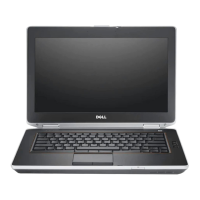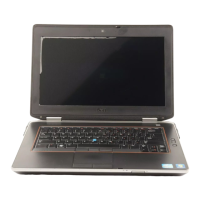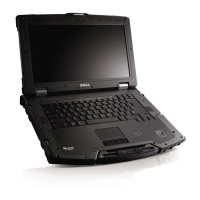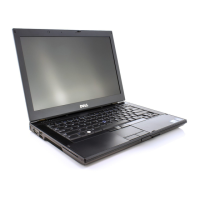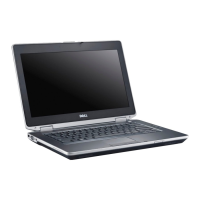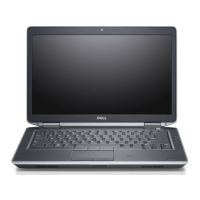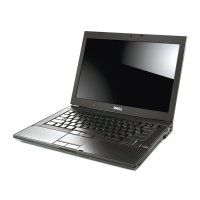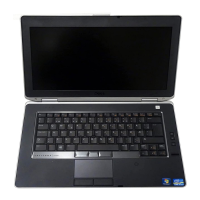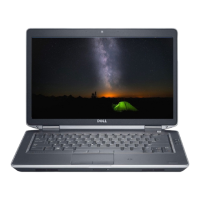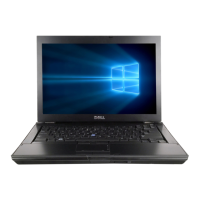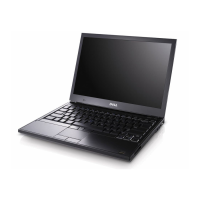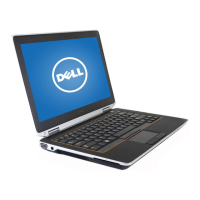Do you have a question about the Dell Latitude E6420 XFR and is the answer not in the manual?
Locates and describes the computer's power button for system operation.
Details the locations and types of USB ports for peripheral connectivity.
Identifies the touch pad and its buttons for cursor control and input.
Details the power input connector and the RJ-45 network port for connectivity.
Locates the panel for accessing and removing the computer's battery.
Alerts users to avoid blocking air vents to prevent overheating and potential damage.
Identifies the mechanism for releasing and removing the battery from the computer.
Locates the sliding cover for the docking device connector on the bottom of the unit.
Indicates the location of the integrated holder for the system's stylus.
Provides critical safety warnings regarding battery handling, replacement, and electrical disconnection.
Details the procedure for releasing the rear panel and lowering it to access the battery.
Guides users through inserting the battery and securing the access door.
Emphasizes safety precautions before removing the hard drive, including power and cable disconnection.
Details the steps to open the access door, press the locking button, and pull the hard drive.
Explains how to open and close the docking device connector door by sliding.
Describes how to unlock and open press-latch doors on the back and right side panels.
Details the procedure for opening and closing slide-latch doors on the unit.
Explains how to open the front SD card door and insert/eject a secure digital card.
Provides safety warnings for AC adapter usage and electrical outlet compatibility.
Instructs on connecting the AC adapter to the computer and the electrical outlet.
Guides the user on connecting the optional network cable.
Describes enclosed smart cards and their access via the left front side door.
Explains contactless smart cards and their access point to the right of the touchpad.
Details how RF signals pass through docking stations to external antennas for improved radio performance.
Explains using the touch screen with fingers/stylus and warns about potential damage from abrasive objects.
Informs about pre-loaded drivers and documentation for the touch display for experienced users.
Introduces the eGalaxTouch utility for configuring touch features and launching its documentation.
Lists and briefly describes the purpose of each tab within the utility: General, Tools, Setting, Display, Edge Parameters, Hardware, About.
Explains 4 Points Calibration and Linearization functions for improving touch screen accuracy.
Details the Draw Test function used for checking touch screen accuracy and performance.
Covers enabling beep sounds on touch and selecting linearization styles (9 or 25 points).
Configures double click time, area, and five mouse emulation modes for touch screen behavior.
Explains configuring the touch screen working area for multiple monitor systems.
Describes the edge compensation tool for touching areas near the screen edge without accuracy loss.
Details how to view the eGalaxTouch controller's model and firmware version.
Provides information about the eGalaxTouch driver, including a link to download the latest version.
Lists key system specifications including chipset, processor, and memory details.
Details audio type, controller, conversion, interface, speakers, and volume controls.
Outlines video type, data bus, controller, and output connector specifications.
Details discrete video controller, UMA graphics, and output connector types.
Covers network adapter and wireless communication specifications.
Details audio, video, and network ports, including warnings about sound pressure.
Lists USB, eSATA/USB, serial, and 5-in-1 memory card reader specifications.
Provides display size, active area, dimensions, and maximum resolution.
Specifies maximum brightness, operating angle, refresh rate, and viewing angles.
Details keyboard key count, layout, and touchpad active area dimensions.
Lists battery type, dimensions, weight, charge time, voltage, and temperature range.
Details AC adapter type, input voltage, and maximum input current.
Specifies AC adapter input frequency, output power, output current, and rated voltage.
Provides physical dimensions, operating/storage temperatures, humidity, and altitude limits.
Directs users to safety, warranty, terms, regulatory, ergonomics, and EULA information.
Locates and describes the computer's power button for system operation.
Details the locations and types of USB ports for peripheral connectivity.
Identifies the touch pad and its buttons for cursor control and input.
Details the power input connector and the RJ-45 network port for connectivity.
Locates the panel for accessing and removing the computer's battery.
Alerts users to avoid blocking air vents to prevent overheating and potential damage.
Identifies the mechanism for releasing and removing the battery from the computer.
Locates the sliding cover for the docking device connector on the bottom of the unit.
Indicates the location of the integrated holder for the system's stylus.
Provides critical safety warnings regarding battery handling, replacement, and electrical disconnection.
Details the procedure for releasing the rear panel and lowering it to access the battery.
Guides users through inserting the battery and securing the access door.
Emphasizes safety precautions before removing the hard drive, including power and cable disconnection.
Details the steps to open the access door, press the locking button, and pull the hard drive.
Explains how to open and close the docking device connector door by sliding.
Describes how to unlock and open press-latch doors on the back and right side panels.
Details the procedure for opening and closing slide-latch doors on the unit.
Explains how to open the front SD card door and insert/eject a secure digital card.
Provides safety warnings for AC adapter usage and electrical outlet compatibility.
Instructs on connecting the AC adapter to the computer and the electrical outlet.
Guides the user on connecting the optional network cable.
Describes enclosed smart cards and their access via the left front side door.
Explains contactless smart cards and their access point to the right of the touchpad.
Details how RF signals pass through docking stations to external antennas for improved radio performance.
Explains using the touch screen with fingers/stylus and warns about potential damage from abrasive objects.
Informs about pre-loaded drivers and documentation for the touch display for experienced users.
Introduces the eGalaxTouch utility for configuring touch features and launching its documentation.
Lists and briefly describes the purpose of each tab within the utility: General, Tools, Setting, Display, Edge Parameters, Hardware, About.
Explains 4 Points Calibration and Linearization functions for improving touch screen accuracy.
Details the Draw Test function used for checking touch screen accuracy and performance.
Covers enabling beep sounds on touch and selecting linearization styles (9 or 25 points).
Configures double click time, area, and five mouse emulation modes for touch screen behavior.
Explains configuring the touch screen working area for multiple monitor systems.
Describes the edge compensation tool for touching areas near the screen edge without accuracy loss.
Details how to view the eGalaxTouch controller's model and firmware version.
Provides information about the eGalaxTouch driver, including a link to download the latest version.
Lists key system specifications including chipset, processor, and memory details.
Details audio type, controller, conversion, interface, speakers, and volume controls.
Outlines video type, data bus, controller, and output connector specifications.
Details discrete video controller, UMA graphics, and output connector types.
Covers network adapter and wireless communication specifications.
Details audio, video, and network ports, including warnings about sound pressure.
Lists USB, eSATA/USB, serial, and 5-in-1 memory card reader specifications.
Provides display size, active area, dimensions, and maximum resolution.
Specifies maximum brightness, operating angle, refresh rate, and viewing angles.
Details keyboard key count, layout, and touchpad active area dimensions.
Lists battery type, dimensions, weight, charge time, voltage, and temperature range.
Details AC adapter type, input voltage, and maximum input current.
Specifies AC adapter input frequency, output power, output current, and rated voltage.
Provides physical dimensions, operating/storage temperatures, humidity, and altitude limits.
Directs users to safety, warranty, terms, regulatory, ergonomics, and EULA information.
| Graphics | Intel HD Graphics 3000 |
|---|---|
| Processor | Intel Core i5 or i7 |
| Display | 14.0 inch HD (1366x768) |
| RAM | Up to 8GB DDR3 |
| Storage | Up to 500GB HDD |
| Operating System | Windows 7 Professional |
| Battery | 6-cell or 9-cell |
| Connectivity | Wi-Fi, Bluetooth |
| Ports | USB 2.0, HDMI, VGA, Ethernet |
| Ruggedization | MIL-STD-810G |
